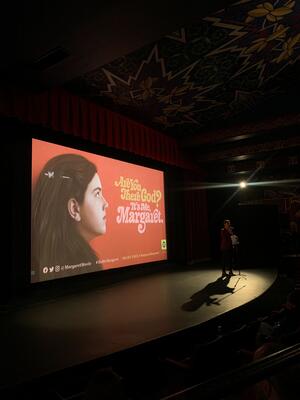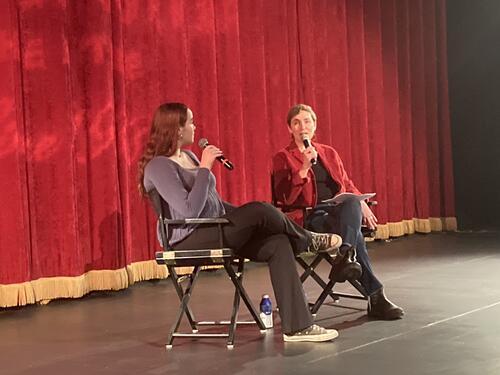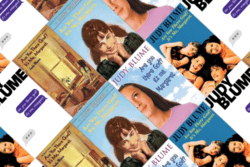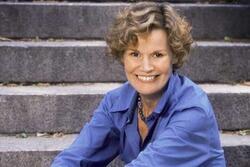Celebrating and Challenging Margaret in Book and Film
Last Sunday, the Jewish Women’s Archive held an advance screening of the film adaptation of Judy Blume’s Are You There, God? It’s Me, Margaret, and it felt like a party. Not only because it was JWA’s first big public event since Covid, not only because it was (for me, at least) the first time seeing a movie in the theater in three years, but also because the theater was packed with people—mostly middle-aged women, some with their kids and/or their mothers—who brought deep, almost reverent, love for the book and for Judy Blume. We had cherished it in our own childhoods or read it with our daughters. We had waited decades to see the story brought to life on the big screen. From the moment that the first scene, in all its 1970-era technicolor, appeared on the screen, the emotions overflowed: lots of laughter, and a fair bit of tears, too.
When the movie ended, and the clapping, cheering, and sniffling had subsided, I led a conversation with the audience. (The conversation was especially sweet for me, as I was joined on stage by my own 16-year-old daughter, who shared her perspective on the meaning of this story for her generation.) Our discussion was wide-ranging, from the choice to keep the 1970 setting, to the expansion of Margaret’s mom’s story line, to the vast change in the experience of kids from interfaith families over the past 50 years. We pointed out some ahistorical moments in the film; for example, unlike the depiction of Margaret’s grandmother’s synagogue, there were no female cantors in 1970, and it’s doubtful Margaret’s suburban school would have been as integrated as it was in the movie, nor would she have been likely to have a male African American teacher there. And of course, the original “sanitary napkin belts” were nowhere to be seen, replaced by (admittedly old-school bulky) pads.
Despite the earnestness of the conversation, rooted in the audience’s shared commitment to taking this book—and girls’ coming of age—very seriously, the tenor of the event was joyful, even celebratory.
So I’ll admit that I was caught off guard when my friend Thea bravely raised her hand and offered a very different perspective. “As a lesbian who grew up around the same time as Margaret,” she said, “I didn’t see myself in this movie at all… Frankly, I was cringing through most of it.” Furthermore, she said, she had considered bringing her 13-year-old non-binary child, and was now relieved that she hadn’t, as this movie would only have further emphasized their exclusion from what it depicts as girls’ “normal” excitement about puberty.
I appreciated Thea’s comments and her willingness to point out that the festive atmosphere in the room presumed shared experience and was not inclusive of all. Suddenly, the assumed binary categories on which the story depends no longer seemed like part of the 1970s setting, but rather an unfortunate gap in representation. After all, didn’t the power of Are You There, God?, and so many of Blume’s other books, stem from her insistence on depicting what had never been allowed to be shown before?
This question weighed heavily on me as I left the theater, and I’ve carried it around with me all week. Though I gave the film a rave review to everyone who asked, internally I wondered if perhaps it had also missed an opportunity in its faithfulness to the original source material.
As I puzzled over this question, I came to realize that the answer (for me, at least) lies in distinguishing between the experience of the screening and of the book itself. The screening was delightful, exultant, and tender—and a bit of a nostalgia fest. Nostalgia is not a great setting for nuance, for parsing distinctions in experience. It’s a celebration of shared experience (or imagined experience), casting a rose-tinted glow on the past and skimming over difference. In this particular context, it felt like a feminist act to come together to honor this groundbreaking representation of girlhood and lovingly laugh at the trials of puberty and our younger selves. (To be fair, we also engaged in a serious conversation and asked some hard questions, so it wasn’t only nostalgia.) At the same time, the “insider” atmosphere—which women don’t get access to very often and sometimes long for—was specific in its own way. Much like the concept of “sisterhood” itself, the assumptions on which it was based didn’t encompass the wide range of women’s experiences. I’m truly sorry about that.
But I don’t think this critique holds for the book itself. Though it’s tempting, more than 50 years after it was first published, to read the book primarily as a “period” piece (pun intended), we can’t afford to forget its radicalism. It is, after all, one of the most banned books in history! Are You There God? highlights that every person going through puberty feels that she is not normal. The book is often described as “normalizing” girls’ experience of puberty, but in doing so, it challenges the whole concept of “normal”! Margaret and her friends long to be normal; they want to grow breasts and get their periods. But the book also shows that some people—like Laura Danker, who developed earlier—are not eager for and do not enjoy these changes. No one feels like it’s happening the right way or at the right time.
Moreover, while the book only depicts cisgender, heterosexual people, it subtly critiques the rigidity of social rules and expectations, represented by bossy, know-it-all Nancy the enforcer, who is revealed, at the end of the book, to be basically full of shit and not as powerful as she thinks she is. In 2023, Nancy would probably make fun of a non-binary kid facing puberty with panic, but Margaret would quietly resist that limited view of gender and make room for the reader to do so, too. That potential lives in the text.
So, go see the movie—I loved it—and celebrate the sweetness of more than 50 years of Blume’s honest embrace of girlhood and its challenges. And then re-read the book, whose radicalism is far from faded into nostalgia.









Thanks for sharing these thoughts for those of us who couldn't go to the screening (and might never see the movie.) And thanks to Thea for bringing up important questions and critiques. I re-read the book a few years ago and was so struck by the casual and not-so-casual misogyny, the intense antipathy towards interfaith families and relationships, the visceral anxiety around puberty. I wonder about where our society has and hasn't moved on these issues. I respect the book and Judy Bloom a lot, but I probably wouldn't bring myself to watch the movie.